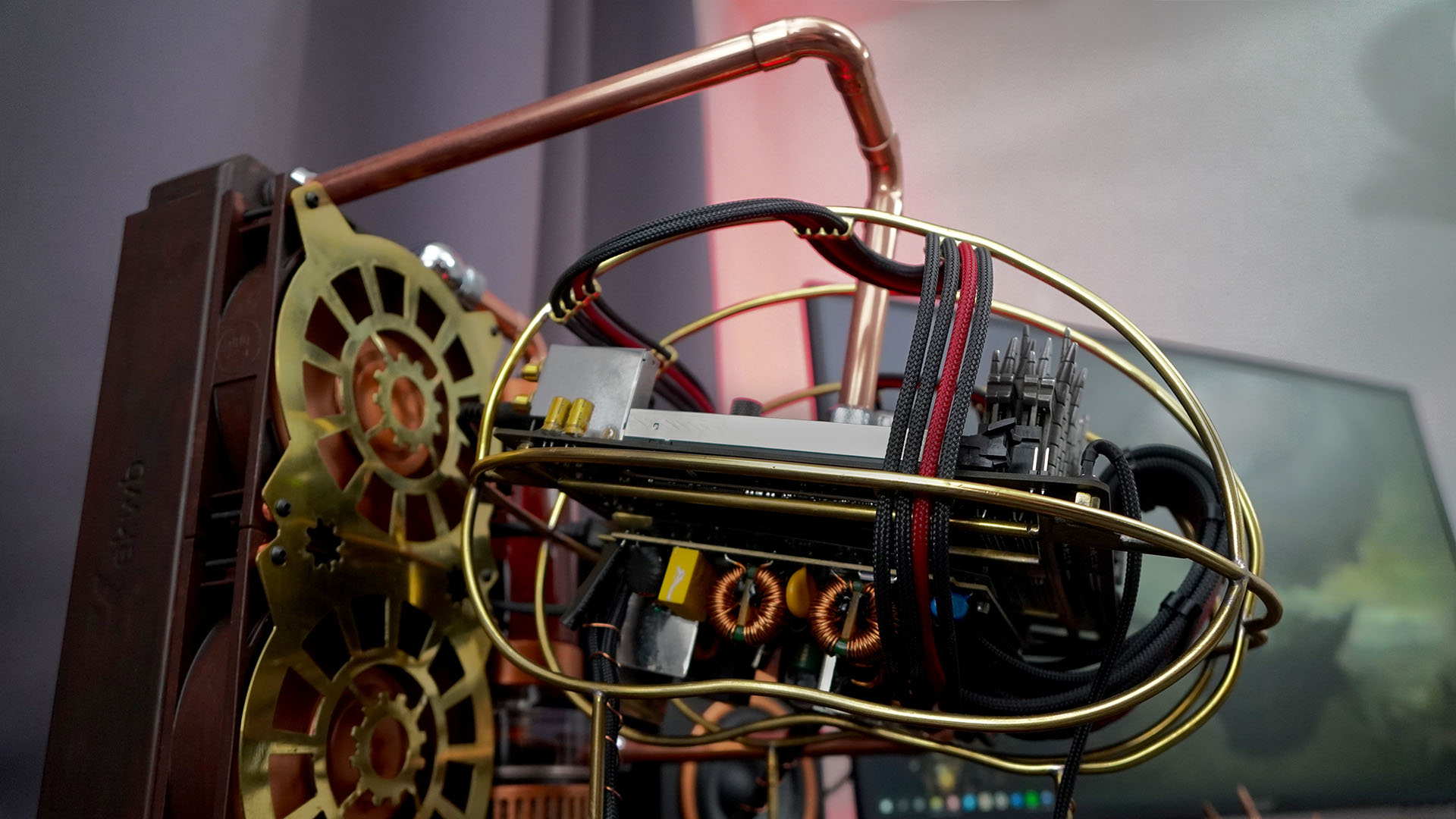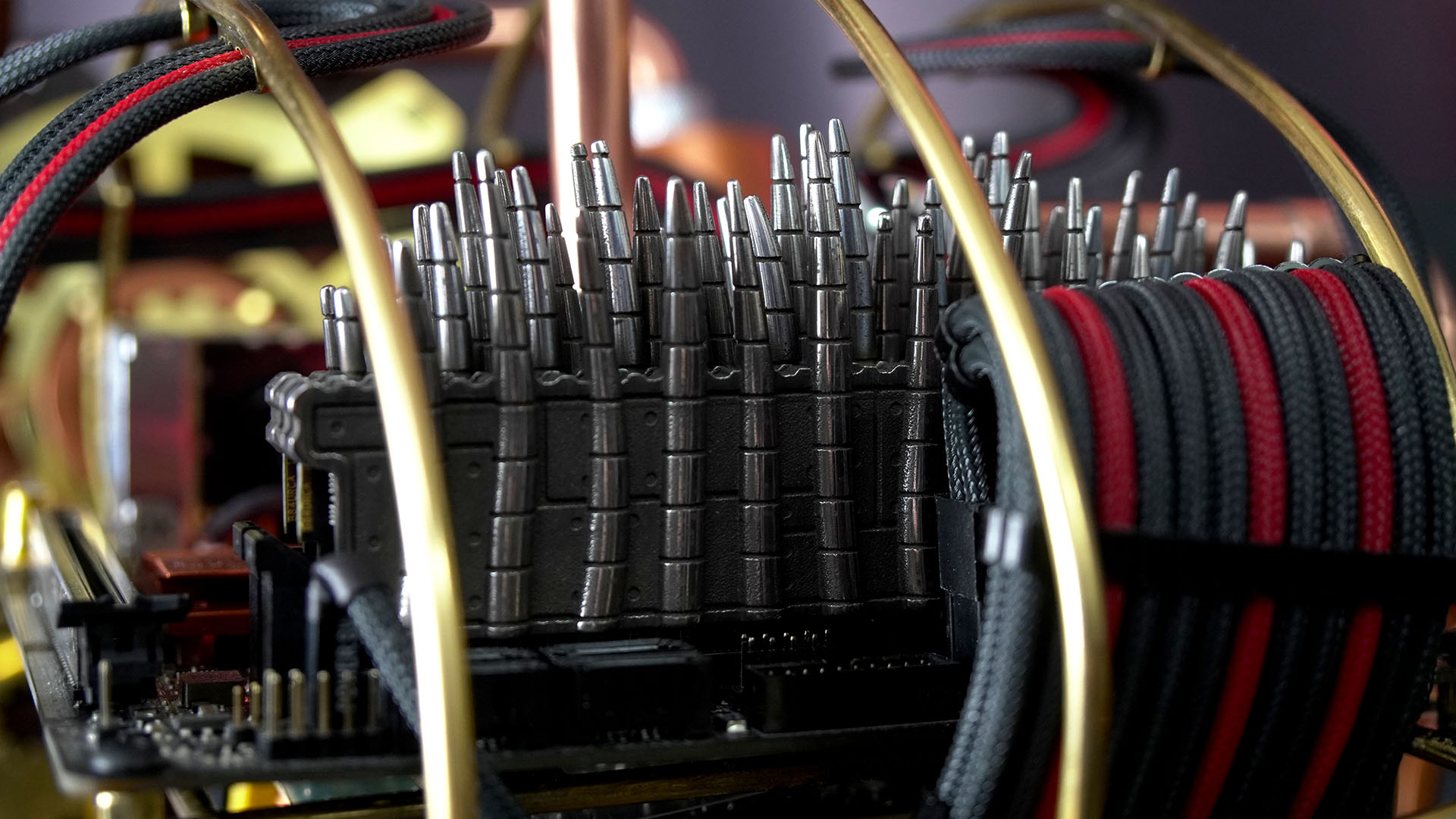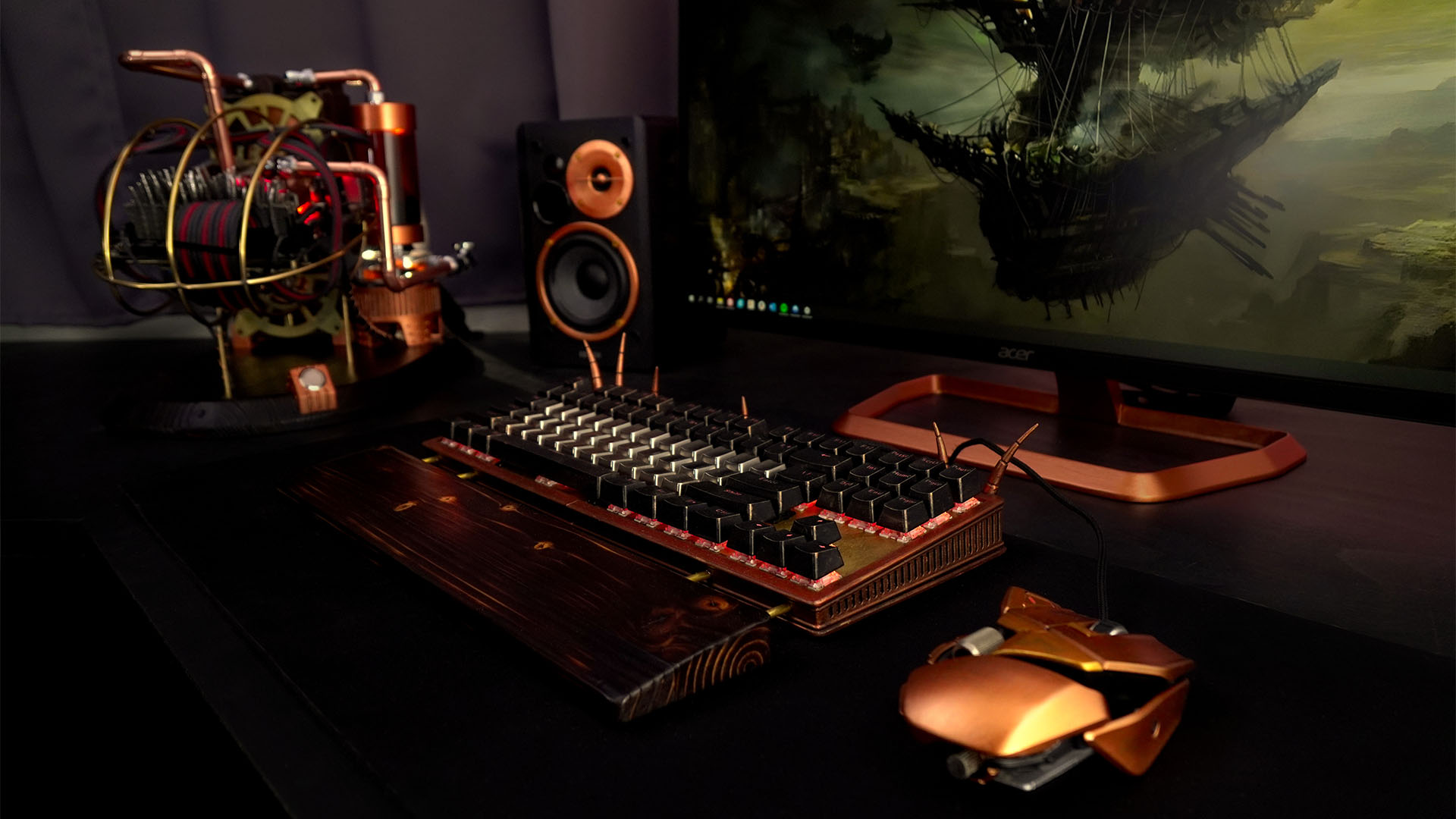Inspired by the idea of a brain in a jar connected to a computer, PC builder David Wieland created this steampunk PC called Posthuman. It makes use of wooden elements, along with CNC-machined metal, copper tubing for the water-cooling system and 3D-printed parts, plus it even has a custom matching keyboard.
Thanks to our rapidly growing PC building Facebook page, we’ve seen many custom gaming PCs, from mods based on existing case designs to scratch PC builds. You can even submit yours for consideration right here. Now let’s chat to David about how his steampunk PC was built.
PCGamesN: Let’s start at the beginning. What inspired you to build this PC – what were your design inspirations and what look were you trying to achieve?
I’d wanted to build a steampunk-themed PC for a while, so when I needed a computer for my workshop, I spent months building a PC from scratch, instead of just buying a practical and cheap box.
The main concept is having a brain connected to a computer in a vat – it thinks it’s a real person but only exists virtually. I then switched that idea around and made the computer the brain. To stay true to the steampunk style, I featured a lot of copper and brass elements. For the base, I wanted an antique-looking piece of wood to make the whole system look like it had been around for a while.

On your project log, you originally intended this to be a full-immersion mineral oil project. What happened to that idea?
In the beginning, I planned to submerge the whole computer in a fish tank to achieve the ‘brain in a jar’ aesthetic, and abandoning this idea was not a decision I took lightly.
The main reason was that, due to my overly high expectations of the quality of workmanship, every part of the process took forever, and no end seemed in sight. After putting the build aside for a few months, I then decided to simplify it drastically, so I could finish it in a reasonable time frame.
As the mineral oil cooling idea complicated the whole build, I was worried it might cause problems and I decided to abandon it. I didn’t have to change too much of the build to move to water cooling, as I already needed a radiator and pump to keep the oil cool.
It’s just a shame that I couldn’t use the custom CPU waterblock (pictured below) I’d made any more. Since the whole computer was originally going to be submerged, the block only had an inlet directing the cooled oil onto the fins, and was then open on the sides – that’s not ideal if you’re using water though.

How did you plan and design this build throughout its various stages?
While I’ve used Fusion 360 in the past to model every bolt of a build before getting started, this time I took a different approach. To get the first rough measurements, I used my own ‘CAD’ process, which I call ‘cardboard-aided design’. I built a rough model with old boxes and some wire.
From there, I just made it up as I went. This was definitely outside of my comfort zone, but it allowed me to work with much more organic shapes that I would have never considered in CAD. The only parts I 3D-modelled were the ones I needed to 3D-print or cut out with a CNC machine.
How did you plan the copper plumbing system, and how did you go about cutting, polishing and linking it all together?
Finding the copper tubing was probably the only part of this build that went much easier than I expected. I just went to the local hardware store and picked up some 12mm plumbing parts. While I would have liked to go bigger, 12mm (diameter) is the only size that’s both common in plumbing around here and has PC water-cooling fittings available.
To connect them, I used regular plumbing solder, which only left polishing. I started by filing away excess solder and then moved up through the sandpaper grits. Finally, I used a polishing paste and a handheld polishing wheel to get it to shine. I have nightmares about all the polishing involved in this project – it was my least favorite part of the building process.

How did you dismantle the PSU, and how much work was involved in crimping and sleeving the cables?
The power supply is a 400W SFX model from be quiet!, which came with good old ketchup and mustard cables. To fit it underneath the motherboard without being too bulky, the enclosure had to go.
Since it was originally supposed to be submerged in mineral oil, safety wasn’t much of a concern originally. The way it’s mounted now is not recommended and could be quite dangerous. It’s properly grounded and none of the live wires is exposed, but I only kept it this way knowing that I would be the only person ever using this PC. The hardest part of making the custom cables was soldering them back into the power supply.
The wires I chose are slightly thicker than the stock ones, so it’s a tight fit once they have the sleeving on top of them. Getting the lengths exactly right for all the cables was also crucial, as they’re completely in view with nowhere to hide any slack. Customizing the pump and fan cables was a breeze in comparison.
You made your own custom frame parts to mount the components, as well as cable combs. Tell us about the metals you used, and how you shaped them and secured them together.
The entire brain frame is made from brass, which I mostly cut by hand and soldered together. The 4mm round stock was just soft enough to be easily bent into shape, but also strong enough not to deform. The cable combs were CNC-machined on my RatRig Killerbee CNC machine, and I also CNC-machined the wooden base and the brass fan grille.
As these parts are all fairly simple, they were perfect projects to learn how to use my newly built CNC machine. To give the base an aged look, I used a blowtorch to char it almost completely, leaving only a few light spots. I then used a Scotch Brite pad to remove all the charring. The resulting surface had a great color as well as some texture as if it had been around for a hundred years. To protect the wood and my fingers, I coated it in a satin varnish.

We love the custom memory heatsinks. How did you design them and get them made?
The custom heatspreaders and the original CPU waterblock are by far my favorite parts of this build. I modeled them in CAD and then had them 3D-printed from aluminum with a selective laser melting printer. I always wanted to try out that technology but never had a good excuse, so this was the perfect opportunity.
The finished metal 3D prints are quite rough and have a matt finish, so I sanded and polished them. I also attempted to anodize them in a copper color but something in the alloy used for 3D printing didn’t agree with my setup and they turned black, so I went back to just polishing them.
You effectively made your own keyboard for this build. How did you design and make the brass plate?
The custom keyboard was another project that resulted in me procrastinating on this build. I designed it completely in Fusion 360 and made my own PCB using Eagle. I then 3D-printed the parts for the frame and used the CNC machine to cut the brass plate.
The keycaps for the letter blocks are made from actual metal, so I used Gateron Black switches for these keys, as they have a higher activation force compared with the Red switches used for the other keys. This ensures that, even though the metal keycaps are much heavier than the plastic ones, the keys feel almost the same when you’re pressing them down. After a paint job and some software configuration, I had a keyboard to match the PC build. I already had a Mad Catz RAT mouse, which was perfect for this setup after a quick paint job too.

How did you create the copper-effect touches on the heatsinks, radiator, pump/res combo and so on?
At first, I tried to use an expensive copper spray paint I found, but it just ended up looking brown. Then I remembered that I still had some metallic acrylic paints lying around, which worked great. It was a challenge to hide the brushstrokes, but almost anything can be hidden if you use enough weathering. Originally, I also painted some inside parts of the reservoir, but it turned out that the paint wasn’t as waterproof as I thought, so it came right off. Some remnants of that paint are still stuck in the fins of the CPU waterblock today.
Did you come across any difficulties?
For this build, I experimented with many techniques that were completely new to me, so the challenges I faced could fill a book. Figuring out how to solder the brass pieces cleanly was quite difficult. Even after many attempts, I was only eventually saved by a Dremel and a lot of filing to remove all the excess solder. I also had some connections break during polishing, which meant starting over again.
How long did it take you to complete this build, from start to finish?
From start to finish, it took me around nine months, but there were around four or five months where I didn’t do any work on it.
Are you completely happy with the end result, or do you wish you’d done some of it differently in retrospect? Do you plan to make any changes to it at a later date?
I do wish I had stayed with the mineral oil-cooling idea, but most likely the build would still be in pieces now if I’d done that, so I think I made the right call. Now that GPU prices are coming down again, I’ve considered adding one.
However, I don’t really need a GPU in this PC (it’s just a secondary machine) and it would change the aesthetics a lot, plus I would need a new power supply. If I ever feel like I need more GPU power, I might add an external GPU box with its own PSU that just connects through a PCIe riser cable.

Posthuman steampunk PC specs
- CPU: AMD Ryzen 5 Pro 4650G
- GPU: Integrated Radeon RX Vega 7
- Storage: 512GB Samsung M.2
- Memory: 16GB Crucial Ballistix
- Motherboard: ASRock B450 Gaming ITX
- PSU: 400W be quiet! SFX Power 2
- Cooling: Custom water-cooling loop, featuring D5 pump, Corsair CPU waterblock, EK 240mm radiator, EK Vardar Fans
Wow, what a beautiful custom steampunk PC, this is stunning work David – maybe we’re all just mini-ITX brains in jars. We’ve never seen a system quite like this one and we love the attention to detail in the craftsmanship, as well as the overall look of the machine.
This post originally appeared on Custom PC, which has been covering amazing setups for over 20 years and is now part of PCGamesN. Join our nearly 500k member Facebook group to discuss this build.
If you consider yourself to be an expert PC builder, you can submit your own custom PC build to us today for a chance of being featured on PCGamesN in the future.
